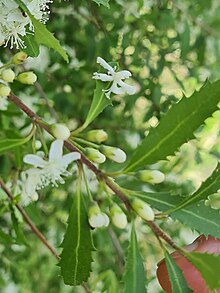| Heterocrossa maculosa | |
|---|---|

| |
| Illustration of male | |
| Scientific classification | |
| Domain: | Eukaryota |
| Kingdom: | Animalia |
| Phylum: | Arthropoda |
| Class: | Insecta |
| Order: | Lepidoptera |
| Family: | Carposinidae |
| Genus: | Heterocrossa |
| Species: | H. maculosa |
| Binomial name | |
| Heterocrossa maculosa (Philpott, 1927) | |
| Synonyms | |
| |
Heterocrossa maculosa is a species of moth in the family Carposinidae. It is endemic to New Zealand and has been found in the southern half of the South Island. Larvae feed on Hoheria angustifolia and Plagianthus regius. Adults are on the wing from November to January. This species is classified as "Data Deficient" by the Department of Conservation.
Taxonomy
This species was originally described by Alfred Philpott in 1927 using a specimen collected from Coopers Knob, Banks Peninsula by Stewart Lindsay and named Carposina maculosa. George Hudson discussed this species under this name in his 1928 publication The Butterflies and Moths of New Zealand. Later that same year Alfred Philpott examined the genitalia of male species of what was then known as C. maculosa. In 1978 Elwood Zimmerman argued that the genus Heterocrassa should not be a synonym of Carposina as the genitalia in this genus are distinctive. Subsequently John S. Dugdale placed this species within the genus Heterocrossa. The holotype specimen is held at the New Zealand Arthropod Collection.
Description
Philpott originally described the species as follows:
♂ ♀ 18 mm. Head, antennae and thorax light buff. Palpi light buff mixed with ochreous on lower half externally. Abdomen ochreous-white. Legs ochreous-white, anterior and middle parts infuscated. Forewings moderate, costa moderately arched at base, thence straight, apex subacute, termen straight, oblique; light buff finely irrorated with pale fuscous; markings fuscous-black; a dot beneath costa near base and a similar one obliquely before it above dorsum; a minute dot beneath costa at 1⁄4 and a much larger one beneath it below fold; a dot in disc beyond these; a dot beneath costa and two below it in disc before 1⁄2; a small dot beneath costa between these and 3⁄4; two or three dots touching each other and forming a short transverse striga at 3⁄4; an obscure irregular striga from costa at 4⁄5 to tornus; a series round termen: fringes whitish-buff. Hindwings and fringes shining white.
Philpott was of the opinion that the distinctive dots as well as the ground colour on the forewings of adults of this species distinguishes it from others in the genus. However Hudson was of the opinion that it was similar in appearance to H. literata.
Distribution
This species is endemic to New Zealand. As well as the type locality, it has been observed in the Lyttelton Hills, Hoon Hay Bush, and in the Aoraki / Mt Cook National Park in Canterbury as well as in Otago.
Biology and behaviour
The adult moths are on the wing from November to January.
Host species and habitat

The larvae feed on Hoheria angustifolia and Plagianthus regius.
Conservation status
This species has been classified as having the "Data Deficient" conservation status under the New Zealand Threat Classification System. The main risks to this species are likely habitat fragmentation and loss.
References
- ^ "Heterocrossa maculosa (Philpott, 1927)". www.nzor.org.nz. Landcare Research New Zealand Ltd. Retrieved 1 June 2018.
- ^ Dugdale, J. S. (1988). "Lepidoptera – annotated catalogue, and keys to family-group taxa" (PDF). Fauna of New Zealand. 14: 131. Archived from the original (PDF) on 27 January 2019. Retrieved 1 June 2018.
- ^ Philpott, Alfred (1927). "N.Z. Lepidoptera: notes and descriptions". Transactions and Proceedings of the New Zealand Institute. 57: 703–709.
- ^ Hudson, G. V. (1928). The Butterflies and Moths of New Zealand. Wellington: Ferguson & Osborn Ltd. p. 218. OCLC 25449322.
- Alfred Philpott (1928). "The Male Genitalia of the New Zealand Carposinidae". Transactions and Proceedings of the New Zealand Institute. 59: 476–480. ISSN 1176-6158. Wikidata Q113369538.
- Zimmerman, Elwood (1978). Insects of Hawaii. Vol. 9. Hawaii: University of Hawaii Press. p. 797. hdl:10125/7338. ISBN 9780824804879.
- ^ Gordon, Dennis P., ed. (2010). New Zealand inventory of biodiversity: Kingdom animalia: chaetognatha, ecdysozoa, ichnofossils. Vol. 2. p. 457. ISBN 978-1-877257-93-3. OCLC 973607714. OL 25288394M. Wikidata Q45922947.
- Hudson, G. V. (1939). A supplement to the butterflies and moths of New Zealand. Wellington: Ferguson & Osborn Ltd. p. 454. OCLC 221041540. Retrieved 9 June 2018.
- ^ Pawson, Stephen M.; Emberson, Rowan M. (2000). The conservation status of invertebrates in Canterbury (Report). Department of Conservation. pp. 41–42. hdl:10182/1658. ISSN 1171-9834.
- ^ Alfred Philpott (30 August 1930). "The Lepidoptera of Mount Cook District, with Descriptions of New Species". Transactions and Proceedings of the Royal Society of New Zealand. 61: 433. ISSN 1176-6166. Wikidata Q66085040.
- Hoare, R.J.B.; Dugdale, J.S.; Edwards, E.D.; Gibbs, G.W.; Patrick, B.H.; Hitchmough, R.A.; Rolfe, J.R. (2017). "Conservation status of New Zealand butterflies and moths (Lepidoptera), 2015" (PDF). New Zealand Threat Classification Series. 20: 8.
| Taxon identifiers | |
|---|---|
| Heterocrossa maculosa | |
| Carposina maculosa | |